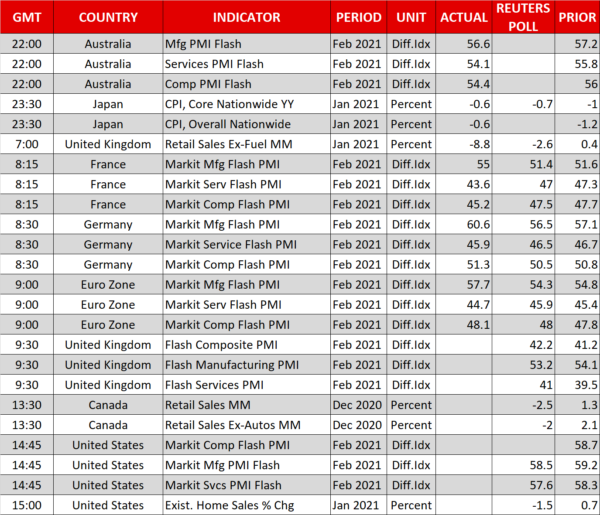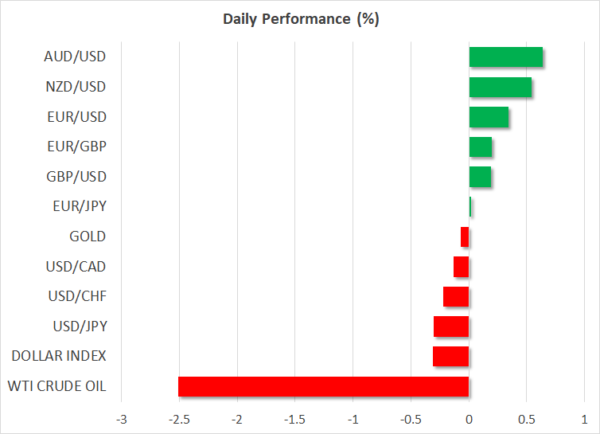- Long-term Treasury yields climb again, dampening the mood in equity markets
- Stocks and gold slide, but dollar stumbles over poor jobless claims figures
- Pound hits $1.40, unbruised by big retail sales miss; aussie soars
Surge in global bond yields spooks markets
Global bond yields are creeping higher again after a brief reprieve mid-week. The record issuance of government bonds and expectations of even greater borrowing to fight the pandemic has sparked a bond selloff as the reflation trade gets into full swing. US Treasury yields bounced back from their post-Fed minutes lows to head towards Wednesday’s highs. The 10-year yield had a fresh pop at 1.30%, while the 30-year yield briefly rose above 2.10%.
But it wasn’t just Treasury yields that were on the rise as European 10-year yields jumped to multi-month highs. Even the yield on 10-year Japanese government bonds shot up, crossing above the 0.1% level that usually prompts the Bank of Japan to step in the bond market to stem further increases.
While the spike in yields does not appear to be worrying the Fed and other central banks just yet, it does appear to be spoiling the mood in equity markets. Up until this week, stocks had been boosted from the reflation theme, but the pause in the rally reflects concerns about how much higher will borrowing costs rise.
Overvaluation fears weigh on Wall Street
In the United States, the main fear is about extreme overvaluation as many stocks that were snapped up while money was cheap would no longer be attractive when financial conditions begin to tighten. Even Treasury Secretary Janet Yellen weighed in on the debate yesterday, saying “there are maybe sectors where we should be very careful”. But in Europe, it is the weaker recovery prospects that would not stand up well for stocks against sharp increases in yields.
Nevertheless, despite yesterday’s losses on Wall Street, there is no sense of panic and the VIX fear gauge is up only marginally. Futures for the S&P 500 and Nasdaq Composite were flat at the European open, indicating the two indices are on track to finish the week lower. Shares in Europe and Asia were mixed today.
Gold and dollar fall in tandem
Gold also took a knock from global jump in yields as the non-yielding bullion becomes less attractive when safe-haven bonds generate higher returns. The precious metal hit a 7½-month low of $1759.29/oz overnight but managed to recover as the US dollar accelerated its decline.
The greenback came under pressure on Thursday after jobless claims unexpectedly rose last week to the highest in four weeks, renewing doubts about the US jobs recovery. The fact that the labour market remains so weak suggests businesses are not yet confident enough about the outlook to hire more people and that consumption is being mostly propped up by the generous stimulus coming from Capitol Hill.
This only underscores the Fed’s cautiousness about the recovery and it seems to have touched a nerve with the dollar, which skidded after the claims data. The greenback has now more than erased its gains from earlier in the week and is down 0.35% against a basket of currencies so far today.
Aussie skyrockets, pound tests $1.40
The dollar’s selloff was broad based, boosting all its rivals. The Australian dollar was the biggest winner, surging past the $0.78 level as it got an extra helping hand from the soaring Australian 10-year yield. The kiwi wasn’t far behind, breaking above the $0.7250 resistance and even the euro joined in the fun, gaining 0.4%.
The laggards were the pound and the Canadian dollar as sterling was held back by dismal UK retail sales numbers for February and a dip in oil prices dragged on the loonie. Still, the vaccine optimism and better than expected flash PMI readings were enough to push the pound above the $1.40 mark for the first time in 34 months.















